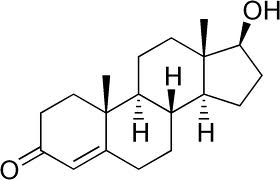
Previously, I have summarized the relationship of
various sex hormones and spinal cord injury. Specifically, I have
reviewed the potential of estrogen and
progesterone to be neuroprotective after
SCI, and most recently provided an overview of
testosterone and testosterone replacement
therapy (TRT). This update will summarize key studies suggesting
that SCI compromises testosterone production, and TRT may ameliorate
some of the ensuing consequences and enhance functional recovery after
injury.
Review
Briefly, testosterone is primarily produced by the
testes in men and, to a lesser degree, the ovaries in women.
Testosterone promotes the development of reproductive tissue, sex
organs, secondary sexual characteristics, sexual function, muscle mass
and strength, and bone density. Because testosterone synthesis is
central-nervous-system-driven process, it is not surprising that a major
CNS insult like SCI affects testosterone levels.
 Low
testosterone is associated with osteoporosis, decreased muscle, reduced
mental acuity, mood changes, fatigue, less libido, and erectile
dysfunction. TRT counters these effects.
Low
testosterone is associated with osteoporosis, decreased muscle, reduced
mental acuity, mood changes, fatigue, less libido, and erectile
dysfunction. TRT counters these effects.
SCI
SCI is also associated with many of these problems.
For example, after injury, 1) skeletal muscle mass atrophies by 30-60%,
and 2) bone loss continues at an enhanced rate for decades. If injury,
indeed, compromises testosterone production and that disruption hastens
post-injury bone and muscle loss, it becomes an extraordinarily
important issue to study, as well as approaches, such as TRT, that may
promote function-enhancing hormone levels.
The results of earlier studies were ambiguous due
to confounding factors, such as participant age, time since injury, and
injury level or completeness. For example, if one study focused on the
acutely injured and another on the chronically injured, results could be
different; or if a study didnít consider such a factor, individual
results could offset each other. As investigations better controlled
these factors, it has become evident that SCI compromises testosterone
levels for many individuals after injury. Key studies are summarized
below:
1) University of Missouri scientists
have carried out several studies evaluating testosterone levels after
SCI. In 2006, they examined testosterone levels in 92 men with SCI
admitted to inpatient rehabilitation. Averaging 39 (range 19-92) years
old, the injuries were roughly evenly divided between paraplegia and
quadriplegia injuries, and complete and incomplete injuries. All had
sustained their injuries within the past 15 years. Although most
guidelines define low testosterone to be below 300 ng/dl [nanogram is
one-billionth of gram; deciliter is one-tenth of liter], the
investigators used 240 ng/dl as a cutoff point, a level they called
abnormally low.
Overall, 83% had levels below this threshold. Men
with more acute injuries (< 4 months) averaged only 160 ng/dl. Given
testosteroneís important body-maintenance role, these are shockingly low
levels that inevitably compromise recovery. Statistically, the odds for
having low testosterone for men with acute versus chronic injuries were
6.7-times greater. Although testosterone differences were noted between
paraplegia and quadriplegic, and complete and incomplete injuries, the
study was not large enough to demonstrate statistical significance.
2) Reported in 2008, the same group
evaluated testosterone levels in 102 men recruited from rehabilitation
facilities. Average age was 46 (range 18-82). Testosterone levels
averaged 220 ng/dl, with 60% of the subjects having abnormally low
hormone levels (i.e., < 240 ng/dl). As before, men with acute injuries
were more likely to have low testosterone. Specifically, 69% of
individuals in the acute-injury phase (<4 months) had low testosterone
compared to only 40% of those in the chronic phase (12+ months).
3) Also in 2008, the investigators reported
the results of treating 50 men with TRT recruited within several weeks
of injury at an inpatient rehabilitation facility. All had low
testosterone levels (averaging 136 ng/dl) and were given monthly,
intramuscular injections of the hormone. Because there was no control
group, the investigators compared motor recovery of their subjects with
the outcomes of 480 non-testosterone-treated men who were included in a
national SCI database. This comparison suggested that TRT promoted
strength gains in men with incomplete injuries already having residual
muscle preservation.
4) Because only a small percentage of total
testosterone is biologically active, free testosterone, Turkish
scientists assessed both total and free testosterone levels in 44
men with SCI recruited from an inpatient rehabilitation unit (2007). The
men averaged 35 (range 16-71) years old, and possessed a spectrum of
complete and incomplete injuries at various neurological levels.
Twenty-seven and 17 subjects had been injured less and more than one
year, respectively. The results indicated that both total and free
testosterone was lower in the group whose injuries were more recent. No
correlation was found between testosterone levels and function as
assessed by the Functional Independence Measure (FIM - a
predictor of oneís overall ability to perform daily-living activities).
5) Led by Dr. William Bauman, clinical
investigators at the James J. Peters VA Medical Center (NY) and
Kessler Institute for Rehabilitation (NJ) have initiated a clinical
trial to examine TRTís potential benefits in 11 men with chronic
SCI with low circulating levels of testosterone compared with 11 men
with normal levels of the hormone. The subjects who had low levels of
testosterone were administered a testosterone patch daily to return
testosterone level to the normal range and, in turn were sequentially
evaluated for possible changes in body composition, energy expenditure,
and other factors.

The results of this preliminary study were recently
reported in Hormones and Metabolic Research. The subjects
averaged 43 years old in the treatment group and 35 years old in the
control group with average durations of injury for these groups of 12
and 13 years, respectively. In the treatment group, eight subjects had
complete injuries and three incomplete injuries. In the control group,
nine subjects had complete injuries and two incomplete injuries. After a
six-month baseline period, TRT was provided for 12 months, after which
there was a six-month washout period in which no hormone was
administered.
The findings were that 12 months of TRT
significantly improved lean tissue mass (i.e., more muscle) and
increased resting energy expenditure (the amount of calories the body
burns during rest is also an indicator of an increased total muscle
mass). These favorable changes have the potential to improve physical
function and general health in men with SCI and low circulating
testosterone levels. Future studies will be required to confirm these
initial findings and to better define changes in functional performance
and other measures of health and well being.
Neuroprotection
As discussed previously, evidence suggests that
estrogen and progesterone can be neuroprotective after SCI. Both inhibit
neuron-damaging processes that occur after SCI and, by so doing, may
preserve function. More limited evidence indicates that testosterone
could also be neuroprotective for a variety of nervous-system disorders,
including Alzheimerís disease, ALS, and perhaps SCI.
Testosterone can cross the blood-brain barrier,
meaning it can actually get to the target neurons. Furthermore, like a
sort of testosterone-specific Velcro, these neurons have receptors that
selectively bind the hormone. This binding can trigger a shift towards
regenerative physiology. For example, studies have shown that
testosterone can increase neuronal differentiation, the outgrowth of
neurites (projections like axons and dendrites), cell-body size,
formation of synapses (connections) between neurons, and plasticity
(processes by which the nervous system returns to normal function).
In SCIís case, studies indicate that testosterone
inhibits damage-perpetuating excitotoxicity that occurs soon after
injury. Basically, after injury, damaged neurons release the excitatory
amino acid glutamate, which can reach toxic concentrations. Through
interactions with receptors on neighboring cells, excessive glutamate
will initiate a neurotoxic, biochemical cascade. Apparently,
testosterone can protect the spinal cord against such damage.
Conclusion
Although we tend to think of estrogen,
progesterone, and testosterone within the context of their more
well-known sexual and reproductive roles, these hormones influence our
physiology on many levels. In the CNS, they exert numerous subtle,
poorly understood effects. As we grow in our understandings, we may be
able to use these effects to better steer an injured cord toward
recovery.
Adapted from article appearing in October 2011 Paraplegia News (For subscriptions,
call 602-224-0500) or go to
www.pn-magazine.com.
TOP